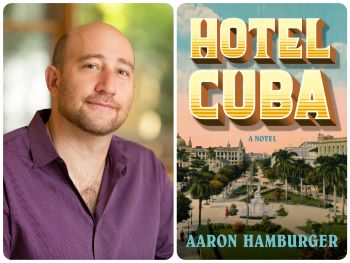The novelist talks Havana, Peter Pan collars, and his indomitable immigrant grandmother.

In Hotel Cuba, Aaron Hamburger’s protagonist, Pearl, is modeled after his own grandmother and her struggles to reach the United States. Pearl is the daughter of a cantor, one of six children from a shtetl that in a few short years gets hit by war, pogroms, famine, and the Russian Revolution. She must escape, but in 1921, America is closing its doors to Jewish immigrants. So, she and her younger sister Frieda go to Havana in hopes of eventually immigrating to the States. (This is during Prohibition, when American tourists are flocking to the island to drink and go wild.) The novel follows their life in Cuba, their attempts to get to the U.S., and the perseverance they must show throughout.
The book is so full of sensory descriptions. How did this relationship with the tactile help to shape your characters?
When Pearl and her sister step off the boat wearing their best woolen clothes in 100-degree heat, we get a sense of how little they know about what they are going toward. They’ve left behind everything they know. Fortunately, Pearl can sew, and she is determined to survive. Also, she’s grounded in good sense and strong values. She knows who she is and what she’s willing and not willing to do. She is always trying to figure out the best course of action, both for herself and for her sister.
But isn’t she much shyer than Frieda?
Yes, she’s shy but not meek. Social niceties and small talk aren’t her strong point. I would describe her as a woman of few but emphatic words, someone with plans and deep-rooted ethics. She may not talk all the time, but when she does, you want to hear what she has to say.
Pearl’s also concerned about her place within her faith tradition. The narrator says, “She knows God is real, just as she knows He is not on her side.” How did this part of the story develop?
In my research, I was very interested in the differences between the educations of boys and girls in the shtetl. For instance, girls needed to be well-versed in the Jewish traditions about keeping kosher, but they were not given the “book-learning” that boys had. Religion defined girls’ lives, but they didn’t receive theological training. So, when Pearl is faced with the events of World War I and the Russian Revolution, she’s ill-equipped to understand how God can let terrible things happen to innocent people. She must grapple with these classical conundrums and answer them for herself.
Her skill as a seamstress is key to her independence. Was it fun to research this side of her?
So much fun. The book required me to get a rapid education in fabrics and fashion, and to become familiar with terms like “drop waist” and “Peter Pan collar.” I learned that colors like dusty pink and mustard yellow were “in” in the 1920s, and so was androgyny in fashion trends.
In fact, she sews trousers for women marching for suffrage.
Yes. I see Pearl as a storyteller, though she used clothing to tell her stories. The book was inspired by a picture I found of my grandmother from 1922 wearing a male outfit: pants, shirt, and tie. When I knew her, my grandmother was a very traditional bubbie, so I was surprised when I came across that picture. I wanted to imagine what she might have thought about the huge shifts going on in the culture at that time. One thing that fascinates me is that Pearl is a take-charge person who puts up with no nonsense and runs her own life, while at the same time, she has little to no interest in things like the right to vote. She wants to be in charge of herself, and she makes money by sewing trousers for the suffragettes, but she is less interested in trying to affect larger forces of change. Perhaps this is because she comes from Tsarist Russia, where that simply didn’t seem possible.
Your depiction of Cuba during that era is especially vivid. What most surprised you in your research?
I didn’t realize what an absolutely carnivalesque atmosphere it was, with American tourists behaving like the worst-behaved drunken teenagers during Mardi Gras; with live sex shows; and with a well-known out gay man who was famous for having the meanest punch in all of Havana. We think we’re so modern and unique, but it turns out that much of what we see now was around in the “olden days,” too. We just use different language for it today.
Do you think the generation that immigrated to the U.S. for a “better life” at that time had certain qualities that we lack in America today?
Maybe it’s more that we don’t know what we’re made of until we’re put to the test, and that generation was put to a huge test. Their lives were incredibly difficult, and they faced their challenges with profound everyday courage.
Do you believe people from that generation have similarities to immigrants to the U.S. today?
Yes. I taught English to immigrants in Brooklyn for four years, and I was amazed and inspired by what they went through to get here.
Would you say this project was close to your heart?
Yes. I enjoyed working on this book and never wanted it to end. It felt like the world’s most fun puzzle to solve.
Virginia Hartman is the author of the 2022 novel The Marsh Queen. She teaches creative writing at George Washington University.

